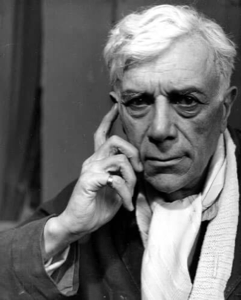Georges Braque
French, (1882–1963)
Braque went to Paris in 1900 and entered the Eco's Nationale des Beaux-Arts and then the Academie In 1904 he favored Fauvism. Cubism was formed by Picasso and Braque. Braque is credited w/introducing into Cubist paintings the use of typography and of decorator's techniques of wood- graining & marbling. His works can be distinguised from Picasso by their fluent painterliness and rich subtle color. Received a serious head wound in 1915, WWI. Began painting again in 1917 w/o Picasso. Between 1930-35 were most fertile of career. In WWII his painting became richer and acquired a spiritual quality with objects in more open space and less involved space.
Georges Braque was at the forefront of the revolutionary art movement of Cubism. Braque's work throughout his life focused on still lifes and means of viewing objects from various perspectives through color, line, and texture. While his collaboration with Pablo Picasso and their Cubist works are best known, Braque had a long painting career that continued beyond Cubism. Braque was also often dedicated to quiet periods in his studio rather than to being a personality in the art world.
Though Braque started out as a member of the Fauves, he began developing a Cubist style after meeting Pablo Picasso. While their paintings shared many similarities in palette, style and subject matter, Braque stated that unlike Picasso, his work was "devoid of iconological commentary," and was concerned purely with pictorial space and composition.
Braque sought balance and harmony in his compositions, especially through papier collés, a pasted paper collage technique that Picasso and Braque invented in 1912. Braque, however, took collage one-step further by gluing cut-up advertisements into his canvases. This foreshadowed modern art movements concerned with critiquing media, such as Pop art.
Braque stenciled letters onto paintings, blended pigments with sand, and copied wood grain and marble to achieve great levels of dimension in his paintings. His depictions of still lifes are so abstract that they border on becoming patterns that express an essence of the objects viewed rather than direct representations.
French, (1882–1963)
Braque went to Paris in 1900 and entered the Eco's Nationale des Beaux-Arts and then the Academie In 1904 he favored Fauvism. Cubism was formed by Picasso and Braque. Braque is credited w/introducing into Cubist paintings the use of typography and of decorator's techniques of wood- graining & marbling. His works can be distinguised from Picasso by their fluent painterliness and rich subtle color. Received a serious head wound in 1915, WWI. Began painting again in 1917 w/o Picasso. Between 1930-35 were most fertile of career. In WWII his painting became richer and acquired a spiritual quality with objects in more open space and less involved space.
Georges Braque was at the forefront of the revolutionary art movement of Cubism. Braque's work throughout his life focused on still lifes and means of viewing objects from various perspectives through color, line, and texture. While his collaboration with Pablo Picasso and their Cubist works are best known, Braque had a long painting career that continued beyond Cubism. Braque was also often dedicated to quiet periods in his studio rather than to being a personality in the art world.
Though Braque started out as a member of the Fauves, he began developing a Cubist style after meeting Pablo Picasso. While their paintings shared many similarities in palette, style and subject matter, Braque stated that unlike Picasso, his work was "devoid of iconological commentary," and was concerned purely with pictorial space and composition.
Braque sought balance and harmony in his compositions, especially through papier collés, a pasted paper collage technique that Picasso and Braque invented in 1912. Braque, however, took collage one-step further by gluing cut-up advertisements into his canvases. This foreshadowed modern art movements concerned with critiquing media, such as Pop art.
Braque stenciled letters onto paintings, blended pigments with sand, and copied wood grain and marble to achieve great levels of dimension in his paintings. His depictions of still lifes are so abstract that they border on becoming patterns that express an essence of the objects viewed rather than direct representations.
Artist Objects



